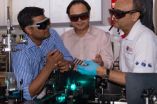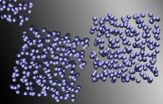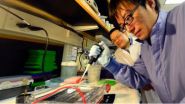(Press-News.org) Researchers at UCL have developed a new antibacterial material which has potential for cutting hospital acquired infections. The combination of two simple dyes with nanoscopic particles of gold is deadly to bacteria when activated by light - even under modest indoor lighting. And in a first for this type of substance, it also shows impressive antibacterial properties in total darkness.
The research, from by Sacha Noimark and Ivan Parkin (both UCL Chemistry) and Elaine Allan (UCL Eastman Dental Institute), is published today in the journal Chemical Science.
Hospital-acquired infections are a major issue for modern medicine, with pathogens like methicillin-resistant Staphylococcus aureus (MRSA) and Clostridium difficile (C. diff) getting extensive publicity. Although medical establishments have stringent cleaning policies, insist on frequent hand-washing by staff, and have powerful drugs at their disposal, it is difficult to eliminate these infections unless you can make the hospital environment more hostile to microbes. Surfaces, such as door handles, medical equipment, keyboards, pens and so on are an easy route for germs to spread, even onto freshly-cleaned hands.
One possible solution to this is to develop alternative strategies such as antibacterial coatings that make surfaces less accommodating to germs. These surfaces are not like antibacterial fluids that just wash away - the goal is to make a surface which is intrinsically deadly to harmful bacteria.
"There are certain dyes that are known to be harmful to bacteria when subjected to bright light," explains the study's corresponding author Ivan Parkin (Head of UCL Chemistry). "The light excites electrons in them, promoting the dye molecules to an excited triplet state and ultimately produces highly reactive oxygen radicals that damage bacteria cell walls. Our project tested new combinations of these dyes along with gold nanoparticles, and simplified ways of treating surfaces which could make the technology easier and cheaper to roll out."
The team, tested several different combinations of the dyes crystal violet (already used to treat staph infections), methylene blue and nanogold, deposited on the surface of silicone. This flexible rubbery substance is widely used as a sealant, a coating and to build medical apparatus such as tubes, catheters and gaskets, and can also be used as protective casings for things like keyboards and telephones.
While work to create antimicrobial surfaces in the past has often concentrated on complex ways of bonding dyes to the surface, this study took a simpler approach. The researchers used an organic solvent to swell the silicone, allowing the methylene blue and gold nanoparticles to diffuse through the polymer. They then dipped the silicone into a crystal violet solution to form a thin dye layer at the polymer surface.
In their tests, in which infected surfaces were subjected to light levels similar to those measured in hospital buildings, surfaces treated with a combination of crystal violet, methylene blue and nanogold showed the most potent bactericidal effect ever observed in such a surface. Moreover, the treatment did not significantly change the properties of the silicone (for instance, how water repellent it is), and the coating was not affected by rubbing with alcohol wipes, meaning it can stand up to the repeated cleaning that goes on in hospitals, without being worn off.
"Despite contaminating the surface with far more bacteria than you would ever see in a hospital setting, placed under a normal fluorescent light bulb, the entire sample was dead in three to six hours, depending on the type of bacteria," says the paper's lead author, Sacha Noimark. "That was an excellent result, but the bigger surprise was the sample which we left in the dark. That sample too showed significant reductions in bacterial load, albeit over longer timescales of about three to eighteen hours. The precise mechanism by which this dark-kill works is not yet clear, though."
This is the first time a light-activated antimicrobial surface has had any kind of effect in the dark. This, along with its unprecedented performance under hospital lighting conditions, and relatively simple and cost-effective manufacture, means that the technology is extremely promising for future applications.
INFORMATION:
The team have been granted a patent on the formulation. The work was sponsored through the UCL M3S engineering doctorate centre and co-funded by Ondine Biopharma.
Notes for Editors
For more information please contact Oli Usher on 020 7679 7964 or o.usher@ucl.ac.uk
'Light-activated antimicrobial surfaces with enhanced efficacy induced by a dark-activated mechanism is published online today in Chemical Science.
About UCL (University College London)
Founded in 1826, UCL was the first English university established after Oxford and Cambridge, the first to admit students regardless of race, class, religion or gender and the first to provide systematic teaching of law, architecture and medicine.
We are among the world's top universities, as reflected by our performance in a range of international rankings and tables. According to the Thomson Scientific Citation Index, UCL is the second most highly cited European university and the 15th most highly cited in the world.
UCL has nearly 27,000 students from 150 countries and more than 9,000 employees, of whom one third are from outside the UK. The university is based in Bloomsbury in the heart of London, but also has two international campuses – UCL Australia and UCL Qatar. Our annual income is more than £800 million.
http://www.ucl.ac.uk | Follow us on Twitter @uclnews | Watch our YouTube channel
World's first light-activated antimicrobial surface that also works in the dark
2014-03-24
ELSE PRESS RELEASES FROM THIS DATE:
NTU scientists discover material that can be solar cell by day, light panel by night
2014-03-24
In future, when your mobile or tablet runs out of battery, you could just recharge it by putting it out in the sun.
Nanyang Technological University (NTU) scientists have developed a next-generation solar cell material which can also emit light, in addition to converting light to electricity.
This solar cell is developed from Perovskite, a promising material that could hold the key to creating high-efficiency, inexpensive solar cells. The new cells not only glow when electricity passes through them, but they can also be customised to emit different colours.
Picture ...
'RoboClam' replicates a clam's ability to burrow while using little energy
2014-03-24
The Atlantic razor clam uses very little energy to burrow into undersea soil at high speed. Now a detailed insight into how the animal digs has led to the development of a robotic clam that can perform the same trick.
The device, known as "RoboClam," could be used to dig itself into the ground to bury anchors or destroy underwater mines, according to its developer, Amos Winter, the Robert N. Noyce Career Development Assistant Professor of Mechanical Engineering at MIT.
Despite its rigid shell, the Atlantic razor clam (Ensis directus) can move through soil at a speed ...
A new concept for manufacturing wrinkling patterns on hard-nano-film/soft-matter-substrate
2014-03-24
Wrinkling is a common phenomenon for thin stiff film adhered on soft substrate. Various wrinkling phenomenon has been reported previously. Wu Dan, Yin Yajun, Xie Huimin,et al from Tsinghua University proposed a new method to control wrinkling and buckling of thin stiff film on soft substrate. It is found that the curve pattern on the soft substrate has obvious influence on the wrinkling distribution of the thin film/soft substrate. Their work, entitled "Controlling the surface buckling wrinkles by patterning the material system of hard-nano-film/soft-matter-substrate", ...
Psychiatric complications in women with PCOS often linked to menstrual irr
2014-03-24
(NEW YORK, NY, March 24, 2014) – Polycystic ovary syndrome (PCOS), a hormone imbalance that causes infertility, obesity, and excessive facial hair in women, can also lead to severe mental health issues including anxiety, depression, and eating disorders. A study supervised by Columbia University School of Nursing professor Nancy Reame, MSN, PhD, FAAN, and published in the Journal of Behavioral Health Services & Research, identifies the PCOS complications that may be most responsible for psychiatric problems. While weight gain and unwanted body hair can be distressing, irregular ...
Statins could ease coughing in lung disease patients, study finds
2014-03-24
Common cholesterol-lowering drugs could provide relief to patients suffering from a chronic lung disease, a study has shown.
The drugs – known as statins – were found to help alleviate the chronic coughing associated with the disease for some patients.
Statins are commonly prescribed for people at risk of heart attack because they can reduce cholesterol levels, but scientists are increasingly finding that they also have anti-inflammatory effects.
Researchers at the University of Edinburgh have shown the therapeutic potential of statins to treat patients with an inflammatory ...
Gene implicated in progression and relapse of deadly breast cancer finding points to potential Achilles' heel in triple negative breast cancer
2014-03-24
NEW YORK – (March 24, 2014) – Scientists from Weill Cornell Medical College and Houston Methodist have found that a gene previously unassociated with breast cancer plays a pivotal role in the growth and progression of the triple negative form of the disease, a particularly deadly strain that often has few treatment options. Their research, published in this week's Nature, suggests that targeting the gene may be a new approach to treating the disease.
About 42,000 new cases of triple negative breast cancer (TNBC) are diagnosed in the United States each year, about 20 ...
Like being inside a star
2014-03-24
Some experiments are really difficult to perform in practice. To gain a detailed understanding of the behaviour of molecular hydrogen (H2), for example, we would have to produce such high pressures as those occurring within the core of gaseous planets like Jupiter and Saturn or inside stars. If such conditions cannot be created, an alternative method is to simulate them on the computer, but the model has to be accurate. A group of research scientists from the International School for Advanced Studies (SISSA) in Trieste used a simulation model that is far more accurate than ...
Pioneering research offers new insight into improved wave energy testing
2014-03-24
Pioneering research could provide a significant boost in the vital quest to harness wave power as a viable renewable energy source for the future.
Scientists from the University of Exeter have studied how wave energy developers can more accurately measure, and predict the wave conditions within wave energy test sites.
The research, which is published in leading scientific journal Energy, deployed wave measurement buoys and used wave modelling to show how variations in wave size and strength could be resolved.
The results should aid developers to better predict sea ...
Maturitas publishes position statement on management of vertebral osteoporotic fracture
2014-03-24
Amsterdam, March 24, 2014 – Elsevier, a world-leading provider of scientific, technical and medical information products and services, today announced the publication of a position statement by the European Menopause and Andropause Society (EMAS) in the journal Maturitas on the topic of the management of postmenopausal women with vertebral osteoporotic fracture.
Vertebral osteoporotic fracture is an underestimated condition as only about a third of people with the disease seek medical attention. While it may cause acute back pain, the presentation may be insidious with ...
Protein called YAP gives blood vessels strength, shape
2014-03-24
AUGUSTA, Ga. - A protein known to promote cancer appears to give the blood vessels strength and shape, researchers report.
When yes-associated protein, or YAP, is deleted from vascular smooth muscle cells during development, the protein makes thin-walled blood vessels that over-dilate in response to the usual pressure of blood flow, said Dr. Jiliang Zhou, vascular biologist at the Medical College of Georgia at Georgia Regents University.
"The thickness of the arterial wall decreases from three or four layers of smooth muscle cells to one or two layers," said Zhou, corresponding ...




